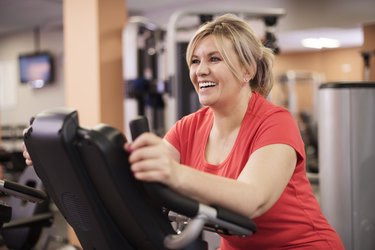
A heart problem can leave you feeling vulnerable and nervous about exercise. Whether you've had a heart surgery or are simply on medication for a heart problem, you need to know that you can trust your heart. That's why the best cardio exercise for heart patients is something light, such as brisk walking.
Starting Slowly
Video of the Day
When you exercise, your heart beats faster and faster. If you have a heart problem, that might make you nervous at first. You might be afraid to exercise, in case something bad happens.
Video of the Day
That's why it's important to start slowly when you get back into exercise. You need to build trust in your heart and slowly increase the intensity. Usually, you'll be under the care of a medical professional who can help you rehabilitate with an exercise program.
Start with light activity for 30 to 60 minutes. You can break this down into multiple exercises sessions of 10 or 15 minutes throughout the day.
Read More: Cardiac Rehab Exercise Guidelines
Walking
Brisk walking is the best exercise that you can do. It's free to leave your house and go for a walk, which makes it ideal for the general population. You should exercise every day while you're recovering, so a cheap form of exercise is best.
If you don't feel comfortable walking outside then you can walk on a treadmill. With a treadmill you can control the speed and incline. You can also monitor your heart rate to make sure you don't exert yourself too much during your workout.
Exercise Bike
If you have a little bit of money to buy workout equipment or to get a gym membership, you can use an exercise bike. Once again, stick to 30 to 60 minutes per day of light exercise. If you choose to use an exercise bike, make sure you monitor your heart rate. It's harder to tell how hard you're working on a bike than if you're walking.

Heart Rate
When you're exercising, the best way to keep track of the intensity is to wear a heart rate monitor. You don't want to get your heart rate too high but it also shouldn't be so low that you're not working hard.
If your doctor doesn't give you a target heart rate, stick to something between easy and intense. Start by finding your maximum heart rate, which is 220 minus your age. Stick between 50 to 70 percent of that number. If you're 50, that means you should stay between 85 and 119 beats per minute, according to an article from the Center for Disease Control.
Warning Signs
As you're exercising, beware of any warning signs. If you start to feel chest pains or dizziness, stop and consult a doctor. You want to build up confidence with exercise but you shouldn't push your body too far. Remember that the heart is sensitive to exercise and take any warning signs seriously.
Read More: The Best Exercises for a Deconditioned Heart
Advanced Exercises
Beyond walking and riding a bike, you can try various forms of cardio exercise as you improve in the rehab process. As your heart regains its strength you can slowly return to your old workout routine, as long as a doctor clears you.
For some people, walking and using an exercise bike won't be enough to strengthen their heart. Swimming is a healthy low-impact exercise for your heart. Riding a bike, hiking and even slow running are also feasible options for cardio.
After you feel confident during cardio exercises, you can return to the most strenuous activity for your heart: weightlifting. When you lift weights your blood pressure increases, which adds stress to the heart. That's why you should save it for after your heart is strengthened by cardio exercises.
- Exercise is Medicine: Exercising with Heart Failure
- British Heart Foundation: How do I start exercising again after a heart attack or heart surgery?
- Therapeutic Advances in Chronic Diseases: Exercise training in chronic heart failure
- American College of Sports Medicine: Exercising with Coronary Heart Disease
- Medline Plus: Being active when you have heart disease